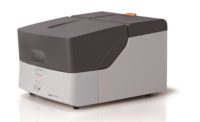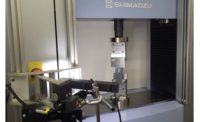Back to Basics: Inspection Using High-Speed Video Cameras
High-speed video cameras capture what the human eye could never see.

Knowing a material’s breaking point is crucial during its development; and being able to observe the instantaneous moment of failure allows for a greater understanding of the process. That, in turn, can help develop stronger and safer materials.
High-speed video cameras allow for this type of observation, recording phenomena that are otherwise invisible to the naked eye and were impossible to capture in the past.
High-speed cameras are used in a variety of industries—ranging from aerospace to sports equipment—to inspect CFRPs, plastics and metals.
The cameras are also often used without testing machines, such as in the visualization of sound waves or observing the atomization process of fuels. As an example, “gasoline being injected from the injector and adhering to the cylinder walls is considered to be a cause of fine particles with a diameter of 2.5 micrometers or smaller harmful particles contained in exhaust gas,” according to Shimadzu. “Ensuring that the gasoline is refined and homogenized during injection is important in regards to improving fuel efficiency.”
Progress
Shimadzu released its first high-speed video camera in 2005. The newest model, the Shimadzu HPV-X2, is capable of recording at 10 million frames per second.
Advanced image sensors using CMOS technology have contributed greatly to the development of high-speed video cameras, according to Shimadzu. With CMOS technology, pixels and memory are spatially separated to achieve high-image quality with no signal leaks.
Shimadzu utilizes a burst image sensor (developed in collaboration with Professor Shigetoshi Sugawa of Tohoku University) which has the same number of built-in memories as number of frames recorded. Furthermore, pixel and memories are connected by wire in a one-to-one manner in order to completely parallel transfer the video signal from the pixels to the memories. This makes it possible to realize ultra-high-speed recording at 10 million frames per second. In addition, since it’s not limited to the number of signal output taps as with conventional serial transfer system, high-resolution recording at ultra high speed is available.
Inspecting CFRPs with High-Speed Video
Inspecting CFRPs provides one of the most instructive examples of using high-speed video cameras in tandem with materials testing.
CFRP is a composite material with a high specific strength. It is used in aircraft and in some transport equipment to reduce fuel costs by reducing weight, according to Shimadzu.
“While it has some excellent mechanical characteristics as a composite material, when in-plane damage occurs it displays brittle failure behavior, with fracture propagating instantly from the point of damage,” according to information provided by Shimadzu.
CFRP development involves not only materials testing, but also observation of material failure in order to check for fracture locations at weak points, such as the periphery of circular holes, according to experts at Shimadzu.
“Furthermore, material failure has recently been observed to evaluate the validity of computer aided engineering (CAE),” according to Shimadzu experts. “In addition, in order to accurately understand the properties of a material, impact properties must be grasped in addition to static properties. In particular, impact testing is necessary since the stress-strain characteristics of a material may differ between when it is subjected to a static load and when it is subjected to an impact load. A high-speed camera allows detailed observation of such an impact test.”
Additionally, tensile testing involves an instantaneous testing time.
“To accommodate this, a strobe capable of emitting intense light instantaneously is used to achieve an image capture speed of more than 1 million frames per second,” according to Shimadzu. “Meanwhile, static testing involves longer testing times with a metal halide lamp used as a light source for continuous lighting (a weaker light source than a strobe), which cannot produce enough light to capture images at more than 500 thousand frames/second.”
Inspecting Impact Properties of Acrylics with High-Speed Video
Understanding the fracture properties of traditional plastics is another common use for high-speed video cameras. In aerospace, engineers must consider the possibility of components sustaining impact loads in order to accurately understand the properties of a material, according to Shimadzu. So, like with CFRPs, impact properties must be grasped in addition to static properties.
The Hopkinson bar method is one method for impact testing. In the method, a “striker bar is fired against an input bar by a bar launcher, transmitting a compressive elastic wave through the input bar to apply a sudden force to the specimen which is contacting the input bar,” according to Shimadzu. In one test example, a specimen made of acrylic resin was tested by the Hopkinson bar method and the fracture behavior of the specimen was observed using the high-speed video camera, recording the test at 500,000 frames per second. Images from the test show that deformation was concentrated at the four corners of the acrylic resin specimen. Other images show the crack propagation during the breakage of the specimen.
“Although crack propagation in impact tests cannot be observed visually due to their extreme speed, in this study, the use of the HPV-X2 enabled a successful observation of the crack propagation,” Shimadzu wrote. “This study demonstrates that the HPV-X2 is a useful tool for evaluating the impact properties of materials.”
Looking for a reprint of this article?
From high-res PDFs to custom plaques, order your copy today!






